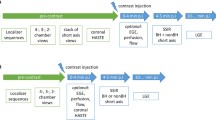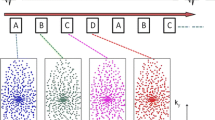Abstract
The aim of this paper is to examine signal-to-noise ratio (SNR), contrast-to-noise ratio (CNR) and image quality of cardiac CINE imaging at 1.5 T and 3.0 T. Twenty volunteers underwent cardiac magnetic resonance imaging (MRI) examinations using a 1.5-T and a 3.0-T scanner. Three different sets of breath-held, electrocardiogram-gated (ECG) CINE imaging techniques were employed, including: (1) unaccelerated SSFP (steady state free precession), (2) accelerated SSFP imaging and (3) gradient-echo-based myocardial tagging. Two-dimensional CINE SSFP at 3.0 T revealed an SNR improvement of 103% and a CNR increase of 19% as compared to the results obtained at 1.5 T. The SNR reduction in accelerated 2D CINE SSFP imaging was larger at 1.5 T (37%) compared to 3.0 T (26%). The mean SNR and CNR increase at 3.0 T obtained for the tagging sequence was 88% and 187%, respectively. At 3.0 T, the duration of the saturation bands persisted throughout the entire cardiac cycle. For comparison, the saturation bands were significantly diminished at 1.5 T during end-diastole. For 2D CINE SSFP imaging, no significant difference in the left ventricular volumetry and in the overall image quality was obtained. For myocardial tagging, image quality was significantly improved at 3.0 T. The SNR reduction in accelerated SSFP imaging was overcompensated by the increase in the baseline SNR at 3.0 T and did not result in any image quality degradation. For cardiac tagging techniques, 3.0 T was highly beneficial, which holds the promise to improve its diagnostic value.






Similar content being viewed by others
References
Vogel M, Gutberlet M, Dittrich S, Hosten N, Lange PE (1997) Comparison of transthoracic three dimensional echocardiography with magnetic resonance imaging in the assessment of right ventricular volume and mass. Heart 78:127–130
Alfakih K, Plein S, Thiele H, Jones T, Ridgway JP, Sivananthan MU (2003) Normal human left and right ventricular dimensions for MRI as assessed by turbo gradient echo and steady-state free precession imaging sequences. J Magn Reson Imaging 17:323–329
Sandstede J, Lipke C, Beer M, Hofmann S, Pabst T, Kenn W, Neubauer S, Hahn D (2000) Age- and gender-specific differences in left and right ventricular cardiac function and mass determined by CINE magnetic resonance imaging. Eur Radiol 10:438–442
Miller S, Simonetti OP, Carr J, Kramer U, Finn JP (2002) MR imaging of the heart with CINE true fast imaging with steady-state precession: influence of spatial and temporal resolutions on left ventricular functional parameters. Radiology 223:263–269
Schär M, Kozerke S, Fischer SE, Boesiger P (2004) Cardiac SSFP imaging at 3 Tesla. Magn Reson Med 51:799–806
Gutberlet M, Spors B, Grothoff M, Freyhardt P, Schwinge K, Plotkin M, Amthauer H, Noeske R, Felix R (2004) Comparison of different cardiac MRI sequences at 1.5/ 3.0 T with respect to signal-to-noise and contrast-to-noise ratios—initial experience. Rofo, Fortschr Geb Rontgenstrahlen Neuen Bildgeb Verfahr 176:801–808
Kuijpers D, Ho KY, van Dijkman PR, Vliegenthart R, Oudkerk M (2003) Dobutamine cardiovascular magnetic resonance for the detection of myocardial ischemia with the use of myocardial tagging. Circulation 107:1592–1597
Paelinck BP, Lamb HJ, Bax JJ, van der Wall EE, de Roos A (2002) Assessment of diastolic function by cardiovascular magnetic resonance. Am Heart J 144:198–205
Zerhouni EA, Parish DM, Rogers WJ, Yang A, Shapiro EP (1988) Human heart: tagging with MR imaging—a method for noninvasive assessment of myocardial motion. Radiology 169:59–63
Masood S, Yang GZ, Pennell DJ, Firmin DN (2000) Investigating intrinsic myocardial mechanics: the role of MR tagging, velocity phase mapping, and diffusion imaging. J Magn Reson Imaging 12:873–883
Kuijpers D, van Dijkman PR, Janssen CH, Vliegenthart R, Zijlstra F, Oudkerk M (2004) Dobutamine stress MRI. Part II. Risk stratification with dobutamine cardiovascular magnetic resonance in patients suspected of myocardial ischemia. Eur Radiol 14:2046–2052
Kuijpers D, Janssen CH, van Dijkman PR, Oudkerk M (2004) Dobutamine stress MRI. Part I. Safety and feasibility of dobutamine cardiovascular magnetic resonance in patients suspected of myocardial ischemia. Eur Radiol 14:1823–1828
Kozerke SSM, Fischer SE, Boesiger P (2002) Cardiac SSFP imaging using SENSE at 3.0 T. In: Proceedings of the 10th scientific meeting of the international society for magnetic resonance in medicine (ISMRM 2002), Honolulu, Hawaii, May 2002, p 1736
Hinton DP, Wald LL, Pitts J, Schmitt F (2003) Comparison of cardiac MRI on 1.5 and 3.0 Tesla clinical whole body systems. Invest Radiol 38:436–442
Gutberlet M, Freyhardt P, Spors B, Schwinge K, Grothoff M, Noeske R, Niendorf T, Felix R (2004) Cardiovascular magnetic resonance: imaging at 3.0 Tesla. Imaging Decis 8:23–30
Ryf SKS, Spiegel M et al (2002) Myocardial tagging: comparing imaging at 3.0 T and 1.5 T. In: Proceedings of the 10th scientific meeting of the international society for magnetic resonance in medicine (ISMRM 2002), Honolulu, Hawaii, May 2002, p 1675
International Electrical Commission (IEC) (2002) Recommendation on MRI safety. IEC 60601-2-33/FDIS
King KF, Angelos L (2000) SENSE with partial Fourier homodyne reconstruction. In: Proceedings of the 8th annual meeting of the international society of magnetic resonance in medicine (ISMRM 2000), Denver, Colorado, May 2000, p 1
Pruesmann KP, Weiger M, Scheidegger MB, Boesiger P (1999) SENSE: sensitivity encoding for fast MRI. Magn Reson Med 42:952–962
Noeske R, Seifert F, Rhein KH, Rinneberg H (2000) Human cardiac imaging at 3 T using phased array coils. Magn Reson Med 44:978–982
Hoffmann KT, Hosten N, Ehrenstein T, Gutberlet M, Roricht S, Felix R (2000) The T2-weighted half-Fourier acquired single-shot turbo-spin-echo technic compared to the conventional T2-weighted turbo-spin-echo technic for cerebral magnetic resonance tomography. A sequence comparison. Rofo, Fortschr Geb Rontgenstrahlen Neuen Bildgeb Verfahr 172:521–526
Friedrich MG, Schulz-Menger J, Strohm O, Dick AJ, Dietz R (2000) The diagnostic impact of 2D- versus 3D-left ventricular volumetry by MRI in patients with suspected heart failure. Magma 11:16–19
Gutberlet M, Abdul-Khaliq H, Grothoff M, Schroter J, Schmitt B, Rottgen R, Lange P, Vogel M, Felix R (2003) Evaluation of left ventricular volumes in patients with congenital heart disease and abnormal left ventricular geometry. Comparison of MRI and transthoracic 3-dimensional echocardiography. Rofo, Fortschr Geb Rontgenstrahlen Neuen Bildgeb Verfahr 175:942–951
Greenman RL, Shirosky JE, Mulkern RV, Rofsky NM (2003) Double inversion black-blood fast spin-echo imaging of the human heart: a comparison between 1.5 T and 3.0 T. J Magn Reson Imaging 17:648–655
Wen H, Denison TJ, Singerman RW, Balaban RS (1997) The intrinsic signal-to-noise ratio in human cardiac imaging at 1.5, 3, and 4 T. J Magn Reson 125:65–71
Lotz J, Döker R, Noeske R, Schüttert M, Felix R, Galanski M, Gutberlet M, Meyer GP (2005) In-vitro validation of phase-contrast flow measurements at 3 Tesla in comparison to 1.5 Tesla: precision, acuracy and signal-to-noise ratios. J Magn Reson Imaging 21:604–610
Ohliger MA, Grant AK, Sodickson DK (2003) Ultimate intrinsic signal-to-noise ratio for parallel MRI: electromagnetic field considerations. Magn Reson Med 50:1018–1030
Sodickson DK (2004) Parallel processing. Diagn Imag January:44–52
Reeder SB, Du YP, Lima JAC, Bluemke DA (2001) Advanced cardiac MR imaging of ischemic heart disease. Radiographics 21:1047–1074
Pan L, Lima JA, Osman NF (2003) Fast tracking of cardiac motion using 3D-HARP. Inf Process Med Imag 18:611–622
Bundy JM, Lorenz CH (1997) TAGASIST: a post-processing and analysis tools package for tagged magnetic resonance imaging. Comput Med Imaging Graph 21:225–232
Zhu Y, Hardy CJ, Sodickson DK, Giaquinto RO, Dumoulin CL, Kenwood G, Niendorf T, Lejay H, McKenzie CA, Ohliger MA, Rofsky NM (2004) Highly parallel volumetric imaging with a 32-element RF coil array. Magn Rson Med 52:869–877
Acknowledgements
The paper was supported by a grant from the German Research Foundation (DFG: Fe 206/8-1-723/01) and contains parts of the doctoral thesis of Kerstin Schwinge and Patrick Freyhardt.
Author information
Authors and Affiliations
Corresponding author
Rights and permissions
About this article
Cite this article
Gutberlet, M., Schwinge, K., Freyhardt, P. et al. Influence of high magnetic field strengths and parallel acquisition strategies on image quality in cardiac 2D CINE magnetic resonance imaging: comparison of 1.5 T vs. 3.0 T. Eur Radiol 15, 1586–1597 (2005). https://doi.org/10.1007/s00330-005-2768-z
Received:
Revised:
Accepted:
Published:
Issue Date:
DOI: https://doi.org/10.1007/s00330-005-2768-z




